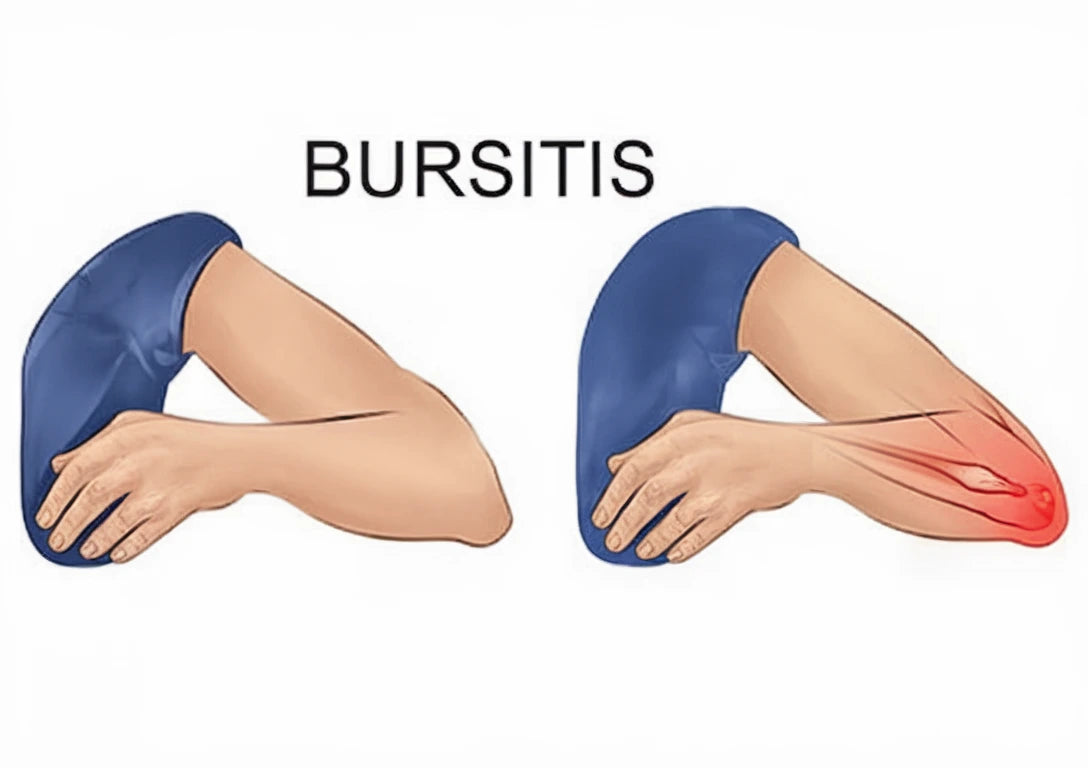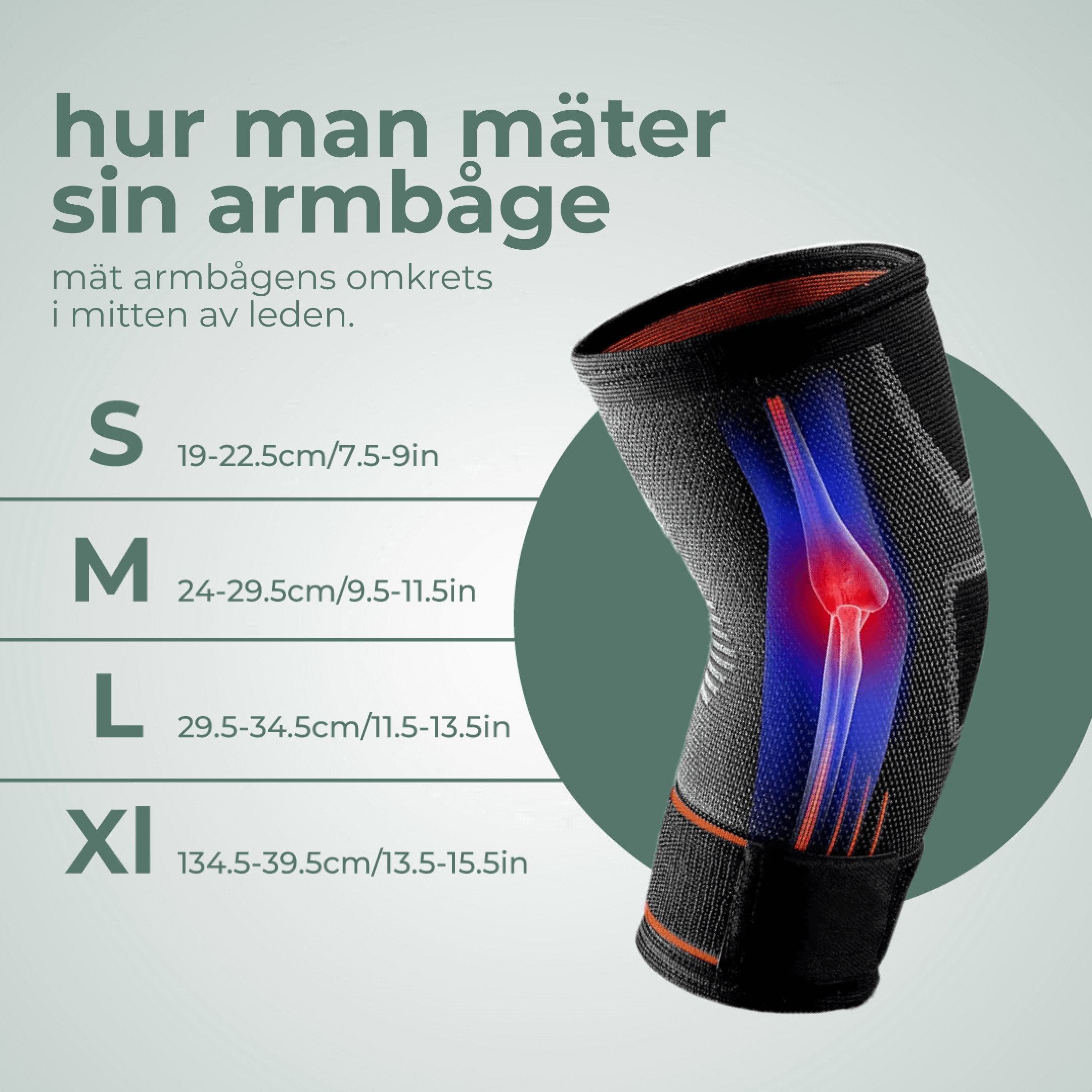Bursitis in the Elbow: Symptoms, Causes, and Treatment

Elbow bursitis, also known as olecranon bursitis or "student's elbow," is a painful inflammation of the bursa that sits over the elbow joint. This article reviews the most common symptoms, causes, and treatment options for elbow bursitis.
What is elbow bursitis?
Elbow bursitis is an inflammation of the fluid-filled sac at the elbow joint, causing pain, swelling, and decreased mobility. Treatment includes rest, anti-inflammatory medications, and physical therapy.
Bursae, also known as bursae, are small fluid-filled sacs that act as cushions between bones, tendons, joints, and muscles. They reduce friction and facilitate movement. When a bursa becomes inflamed, as in elbow bursitis, it swells, leading to pain and limited mobility in the affected area.
Symptoms of bursitis in the elbow
Elbow bursitis can manifest itself in several ways and symptoms can vary in intensity. Common symptoms include:
- Swelling over the elbow: This is often the most visible sign of bursitis. The swelling can be soft and fluid or hard and firm.
- Pain and tenderness: The elbow may be painful to the touch and movement, especially when bending or extending the arm.
- Redness and warmth: The affected area may become red and feel warm to the touch, which is a sign of inflammation.
- Limited mobility: Due to pain and swelling, it may become difficult to fully bend or straighten the elbow.
- Stiffness: The elbow may feel stiff, especially in the morning or after extended periods of inactivity.
Elbow bursitis differs from other elbow pain conditions such as impingement in that the swelling is often visible and localized to the back of the elbow. In some cases, especially if the bursa is infected, more serious symptoms such as fever and increased redness may occur, requiring prompt medical attention.
Causes of elbow bursitis
Several factors can contribute to the development of elbow bursitis:
- Repeated pressure or trauma: Frequently resting the elbow against hard surfaces or subjecting it to repeated impacts can irritate the bursa.
- Overuse: Repetitive movements or overuse of the elbow can lead to inflammation.
- Infection: In some cases, bacteria can enter the bursa and cause infectious bursitis.
- Underlying diseases: Conditions such as rheumatism in the hands and feet can increase the risk of bursitis.
- Occupation or hobby: Certain occupations or activities that require a lot of elbow use may increase the risk.
People who rely on their elbows frequently or who work in occupations that require them to rest on them (such as plumbers or auto mechanics) are at higher risk of developing bursitis. Structures surrounding the elbow can also be affected, sometimes leading to complications involving muscles that extend from the elbow up to the shoulder blade.
Diagnosis and treatment of elbow bursitis
Understanding the cause of elbow bursitis is crucial to choosing the right treatment. This inflammation of the bursa can occur from overuse, pressure, or repetitive motion. For best results, a combination of rest, physiotherapy, and supportive devices such as an elbow brace with Thermorelieve technology is recommended.
Rest and relief
The first and most important measure for elbow bursitis is rest. By reducing the load, the joint has time to recover and the inflammation can subside.
💡 Tip: An elbow support can provide stability and remind you to keep your arm in the correct position during recovery.
Cold and heat therapy
Cold therapy reduces swelling and relieves pain, while heat therapy increases blood circulation and speeds up healing.
With Termorelieve™ technology, you can easily switch between cold and heat – perfect for customizing your treatment as needed.
Anti-inflammatory drugs
For more severe pain, anti-inflammatory medications may be an option. These reduce swelling and discomfort, but should be used as recommended by your doctor.
With the right support, the need for medication can be reduced – elbow support with Termorelieve™ provides natural relief as a complement to treatment.
Physiotherapy
Once the pain subsides, it is important to regain strength and mobility. Physiotherapy will help you build up the muscles around your elbow and prevent recurrence.
A good elbow support provides stability during exercises and helps avoid overextension.
When is further treatment required?
In some cases, especially infected bursitis, antibiotics or surgery may be necessary, but most patients make a full recovery with conservative treatment and proper support.

How Elbow Support and Thermoreliever™ can help with elbow bursitis
Elbow supports and Termoreliever™ offer several benefits for people suffering from elbow bursitis:
- The elbow support provides support and relief to the affected elbow, which can reduce pressure on the inflamed bursa.
- Termoreliever™ offers both cold and heat therapy, which is important for managing inflammation and pain. Cold therapy can be used in the acute stage to reduce swelling, while heat therapy can be used later to increase blood circulation and promote healing.
- The combination of these products can speed up recovery by providing continuous support and pain relief .
- The products can be adapted to individual needs and used both during rest and light activity.
For people who have recurring problems with elbow bursitis, these aids can be particularly valuable in preventing new episodes by relieving pain and reducing strain on the sensitive bursae.
Conclusion
Elbow bursitis can be a painful and limiting condition, but with proper diagnosis and treatment, most people can experience significant improvements. By combining traditional treatment methods with innovative aids such as Elbow Support and Termoreliever™, many can effectively manage their symptoms and regain normal elbow function. It is important to listen to your body's signals and seek professional help if symptoms persist or worsen.
For optimal recovery, it is important to both treat the acute inflammation and identify the underlying causes to prevent recurrence. With the right combination of treatments and preventive measures, most people can return to normal activities without long-term problems .
Frequently Asked Questions (FAQ)
How long does elbow bursitis usually last?
With the right treatment, many people can experience improvement within a few weeks. However, some cases can take longer, up to several months, depending on the severity.
Can I exercise with elbow bursitis?
Light exercise and specific exercises can often be part of treatment, but it is important to avoid activities that aggravate the pain. Consult a physiotherapist for a customized exercise program.
How do I use Termoreliever™ for elbow bursitis?
Use cold therapy in the acute stage to reduce inflammation, usually for 15-20 minutes at a time, several times a day. Then transition to heat therapy to promote healing and increase mobility.
Can the Elbow Support prevent elbow bursitis?
Yes, by providing support and reducing pressure on the elbow, the Elbow Support can help prevent overuse and reduce the risk of bursitis, especially during activities that put stress on the elbow .
When should I seek medical attention for elbow bursitis?
Seek medical attention if the pain is intense, if you have significant swelling or redness, if you have a fever, or if symptoms do not improve after a few days of self-care.

